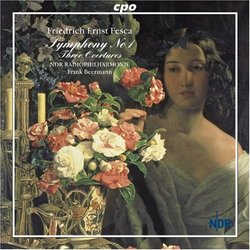An All-But-Forgotten Composer Worth Hearing
J Scott Morrison | Middlebury VT, USA | 08/30/2007
(4 out of 5 stars)
"Born in Magdeburg into an intensely musical family -- his mother was a professional singer, his father a bureaucrat who was an active amateur musician -- Friedrich Ernst Fesca (1789-1826) had an impeccable music education and became an acclaimed violinist. He was developing a growing reputation as a composer when he died of lung disease at the age of 37. This recording of his First Symphony and three overtures follows, after a gap of several years, an acclaimed CD of his Second and Third Symphonies by the same forces, Frank Beermann conducting the NDR Radiophilharmonie. The present CD shows us that Fesca had continued growing as a composer; the later two are more mature and more clearly in Fesca's own voice. The First Symphony seems to take as its model Mozart's Symphony No. 39, one of that composer's three last symphonic masterpieces. It is in the same key and the construction of Fesca's first movement is clearly the same as that of Mozart's. Not a bad model, after all, and there is something extra that Fesca brings to the music, namely what the booklet writer (Bert Hagels) calls 'filigree composing' ('durchbrochener Satz'), a kind of melodic elaboration that possibly springs from Fesca's background as a virtuoso violinist. In this respect he is perhaps closer to his near contemporary, Louis Spohr, who is in fact recorded as having admired Fesca's music.
The symphony is in the usual four movements. The first is in the celebratory key of E flat and, as mentioned, sounds a bit like a knock-off of Mozart's Symphony No. 39. The second movement features chorale-like passages that alternate between strings and winds. The third movement is a minuet that shifts between C minor and E flat major. The finale is a kind of hybrid rondo and sonata allegro; as in the middle part of the first movement, there is considerable expert contrapuntal writing. The symphony ends on a triumphant note. It is given a convincing reading. Although the NDR is a modern-instruments orchestra, there is more than a little attention paid to performance practice of the time, including use of leather-headed sticks for the important timpani part.
The symphony is followed by two stand-alone overtures, Opp. 41 & 43, and the prelude for Fesca's last opera, 'Omar und Leila', Op. 28. These are late works and have some elements that remind one of music by Carl Maria von Weber. They are not profound works, but they were not meant to be. The two concert overtures were primarily intended for use as generic entr'actes for theatrical presentations. 'Omar und Leila' is an oriental fairy tale opera and its overture contains some exoticisms in the orchestration that enhance the cautiously melismatic melodies.
Scott Morrison"

